
Table of Contents
- How Does a Well Pump Work?
- Types of Water Well Pumps - Jet Pumps vs. Submersible Pumps
- Single Drop Jet-Pump System for Shallow Wells
- Double Drop Jet-Pump System for Deep Wells
- Submersible Pump System for Deep Wells
- What Size Well Pump Do I Need?
- Other Well Pumps to Consider
- Key Components to Consider
If you live outside of town, chances are your home will have its own electromechanical system for drawing water from a well. According to the U.S. Census Bureau, over 15 million households rely on private wells for drinking water.
The well pump, which extracts water from underground water sources, is the heart of that electromechanical system. It’s what provides your home with clean, safe drinking water.
How Does a Well Pump Work?
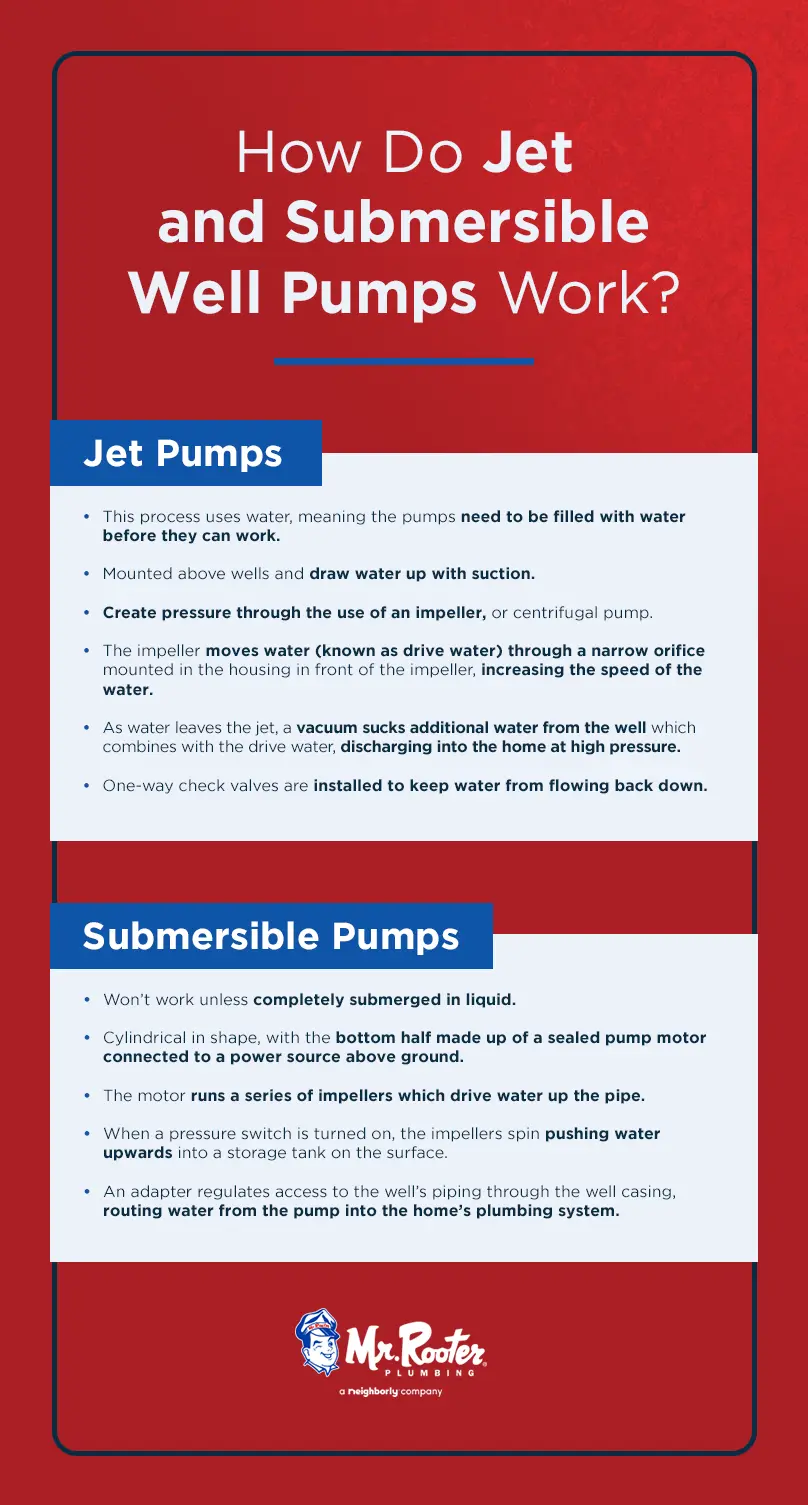
A typical well water system lifts water from an underground well and delivers it to a storage tank where it’s pressurized and stored until it’s 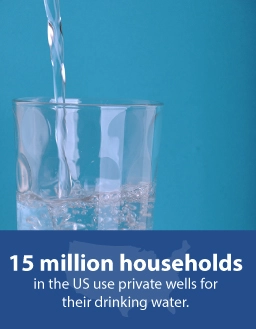 needed. Most pumps are electric and use suction to draw the water through pipes. Most pumps also fall into one of the following two categories:
needed. Most pumps are electric and use suction to draw the water through pipes. Most pumps also fall into one of the following two categories:
- Jet pump – A motorized jet pump assembly includes the pump that moves the water from the wall and a motor to drive the pump. It’s often paired with a pressure tank, which evens out the water throughout the home.
- Submersible pump – A submersible pump also includes a water pump and pump motor in addition to an internal check valve. A submersible pump might not have a pressure tank.
Types of Water Well Pumps — Jet Pumps vs. Submersible Pumps
There are as many different kinds of well pumps as there are requirements, although selection factors often depend on the depth of the water and the diameter of the well casing. Some pumps have special purposes such as boosting water pressure or offering a special water outlet, like a distillation system.
Jet pumps pull water, while submersible pumps work by pushing water upward. Since pushing water requires less energy, submersible pumps are often more efficient for deep wells. Choosing a jet pump or submersible pump will likely depend on the depth of your well.
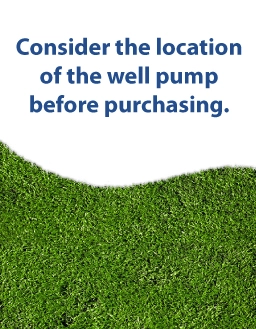 Do I Have a Shallow or Deep Well?
Do I Have a Shallow or Deep Well?
The first consideration is the distance water needs to travel to reach the surface. If your area has a stable supply of water near the surface or a high water table, it will be much easier to access water for your home. Deep wells, on the other hand, require additional considerations.
Depth Considerations – Depending on Where Well Pumps Are Located
- If less than 25’, use a shallow well jet pump
- If 25’ – 110’, use a deep well jet pump
- If 25’ – 400’, use a 4” submersible pump
To find out the depth of your well, check the well driller’s well report. If there’s no such report, you can determine water depth by tying a fishing bobber to the end piece of a string and lowering it until you feel the bobber floating. Take up the slack and mark the string.
Single Drop Jet-Pump System for Shallow Wells
Single drop jet pumps are the best shallow well pumps. They feature one-way check valves to keep pumps primed. The pump sits above ground, drawing water through a single inlet pipe. Because the mechanics are straightforward, they tend to need less maintenance.
Jet pumps, the most common pumps for shallow wells, are mounted above wells and draw water up with suction. The height the water can be lifted depends on the weight of the air. Although air pressure varies with elevation, jet-pump-operated shallow wells are commonly limited to 25 feet.
Jet pumps create pressure through the use of an impeller, or centrifugal pump. The impeller moves water — known as drive water — through a narrow orifice, or a jet, mounted in the housing in front of the impeller. Constriction of the jet causes the speed of moving water to increase. As water leaves the jet, a vacuum sucks additional water from the well. This additional pumped water combines with the drive water, discharging into the home at high pressure.
The process of drawing water with shallow well jet pumps uses water. This means the pumps need to be filled with water before they can work. One-way check valves are installed to keep the water from flowing back down the well.
Double Drop Jet-Pump System for Deep Wells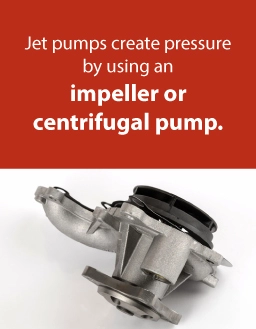
A deep-well jet pump also sits above ground, but it draws water through the use of two pipes — one to draw water from the well and the second to push water upward. The deep-well jet pumps are designed to extract water from depths up to 110 feet and require a foot valve to prime the pipe. Some models may include a tailpipe to ensure the well is never pumped dry.
Deep-well jet pumps can draw water from depths greater than 25 feet when the jet is separated from the impeller housing and placed down in the water. The impeller drives water down into the jet’s body while the jet delivers water back up to the pump. Deep-well jet pumps use suction at the jet to bring water into the system, as well as the pressure generated by the impeller to lift water from the well and into the home.
To keep the system from over-pumping the well, a deep-well jet pump will include a 25-foot-long tailpipe connected to the intake end of the jet housing. If the water level drops below the level of the jet housing, the tailpipe ensures the well will never be pumped dry. The greater the distance of the jet over the water level, the more efficient the pumping will be.
As with shallow-well systems, a deep-well jet pump system needs to be primed with water. A foot valve at the bottom of the well keeps water from draining from pipes.
Submersible Pump System for Deep Wells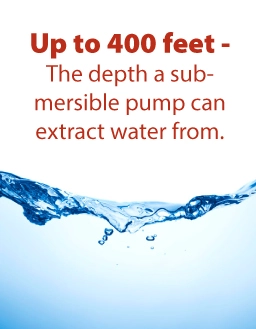
A deep-well submersible pump uses a pressure tank to draw water through a single pipe connecting the inside well to the home. A submersible pump can extract water from depths up to 400 feet, but it must be pulled from the well casing for repairs. Two-wire pumps feature built-in controls while three-wire pumps require a separate control box.
Although jet pumps can still handle depths of several hundred feet, submersible pumps are typically more effective at greater depths. By moving the pump down the well, the pump no longer lifts the water but, rather, pushes it upward. A submersible pump won’t work, however, unless it’s completely submerged in liquid.
Submersible pumps are cylindrical in shape, with the bottom half made up of a sealed pump motor connected to a power source above ground. The motor drives a series of impellers, used to drive water up the pipe. When a pressure switch is turned on, the impellers spin, which draws water into the pump. The water is then pushed through the pump body and into a storage tank at the surface. An adapter, connected to the plumbing system, regulates access to the well’s piping through the well casing, routing water from the pump into the home’s plumbing system.
Unlike above-ground water well pumps, which experience a higher rate of mechanical problems due to the challenge of pulling water from a well, submersible pumps generally encounter fewer problems. Since submersible pumps lie underwater, they never lose prime, which can be a problem for above-ground pumps. Cavitation, which occurs when excess air or gas gets into the mechanical parts of the pump, is also usually not a problem for submersible pumps since the pumps lie deep beneath the water's surface and always have access to water.
Although submersible pumps can be more efficient than jet pumps at delivering more water with a comparable motor, any problems with the motor may require pulling the entire unit from the well casing. Fortunately, submersible pumps are generally known for their reliability, often performing optimally for up to 25 years before needing to be serviced. Submersible pumps are an efficient and low-maintenance way to deliver safe drinking water into your home.
What Size Well Pump Do I Need?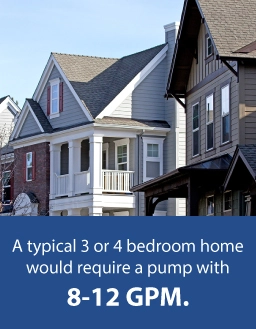
You will also need to determine the best pump size, depending on your water home needs. Pumps are rated in GPM (gallons per minute). A typical 3- to 4-bedroom home requires 8-12 GPM. When determining your home water needs, add one GPM for every water fixture in your home. Such fixtures include clothes washers, dishwashers, faucets, refrigerators, showers, and outdoor water spigots.
Although you’ll need a large enough pump to meet your home water needs, an oversized pump will create energy inefficiencies and reduced performance. When replacing a pump, you should choose a unit with the same horsepower. However, additional horsepower may be necessary if you are adding new appliances or family members. The longer the distance to transport water, the more horsepower will be needed.
If replacing a pump, you can check the identification plate on your pump to determine the horsepower. Keep in mind that submersible pumps may require either three wires or two wires, so you’ll to determine how many wires your replacement pump will need.
Other Well Pumps to Consider
Not all pumps require access to electrical energy. Other pumps options include solar, kinetic, pneumatic and manual: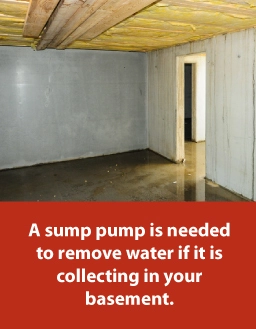
- Solar-powered well pumps – Solar-powered pumps don’t need an external power source, but they operate more efficiently and at a lower overall cost than traditional pumps. Solar panels provide the power needed to pump water from hundreds of feet underground. Recent advances in technology have also made solar-powered systems more affordable. After initial costs, there are no ongoing costs, nor is there a need for power cables.
- Manual pumps – Manual pumps are a lightweight and highly affordable way to ensure a constant supply of water in the event a motor-driven pump stops working. A manual pump is ideal for temporary uses because it can easily be removed from a well.
- Kinetic water ram water pumps – Kinetic water ram pumps use the force of running water, combined with hydraulics, to lift water as much as 150 feet from a pump location. Such pumps are used mostly in agricultural settings because stream water is not likely to be sanitary.
- Air-driven (pneumatic) well pumps – Pneumatic pumps are powered by air rather than electricity. Such pumps are typically used in industrial and commercial settings.
- Sump pumps - If you have water collecting in your basement, you’ll need a sump pump to remove the water. Like well pumps, sump pumps come in two basic forms: submersible sump pumps and floor-level sump pumps. Floor-level pumps are located above the water line to displace water outside the building. A submersible sump pump works the same way. Submersible pumps, however, are located below the water line and can manage higher water volumes than floor-level pumps.
Key Components to Consider
Pump assemblies ordinarily include pump bearings, pump impellers (or rotary vanes), electric motors, pump motor bearings, internal pump check valves, and pump control switches. Key components to consider include the following:
- Check valve - A check valve prevents pumped water from flowing back into the basin.
- Foot valve – A foot valve prevents water from flowing back down to the source when a deep-well pump is turned off.
- Pressure switch – A pressure switch automatically turns water on and off, depending on pressure settings. When the pressure reaches somewhere between 40 to 60 psi, the pressure switch turns off the pump. When pressure gradually decreases due to water use, the pressure switch turns the pump back on, repeating the cycle.

If your pump doesn’t turn off, it could indicate a problem with pressure switch settings. A pump also might not shut off if the well water is too low or if there’s a leak in the drop line.
- Pressure tank – A pressure tank helps regulate water flow and maintain water pressure to better keep appliances running efficiently. The pressure tank is necessary to ensure consistent water pressure at all fixtures. By first pumping the water into a tank, the water becomes compressed so it can be moved evenly through the entire household plumbing system.
A pump that starts too frequently might indicate the need for recharging or even the possibility of a leak.
- Pressure-sensitive pumps and inline pump controllers – Pressure-sensitive pumps provide water boosting without the need for a water pressure tank.
- Safety rope – Safety ropes help recover pumps for easier access when maintenance is needed.
Although most buildings generally require the same types of water pumps, special conditions may call for something more unique. Be sure to consider all of your needs before purchasing a well-water pump.
Improving Your Well Pump’s Life Expectancy
An above-ground, one-line or two-line jet pump can operate for a number of years before requiring replacement — as few as four to as many as 15 to 20. A submersible pump in low-sediment water can offer a 15-year life, although high-sediment water can cause pumps to fail sooner.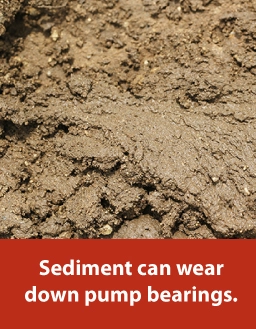
The following factors may affect the expected life of a well pump:
- Duty cycle – A pump with an intermittent duty cycle will have a longer life than a pump with heavy or continuous use.
- Motor size – A larger electrical motor (i.e. 1 horsepower or more) will typically outlast a fractional electrical motor. The more powerful the motor, the less often it will have to run.
- Motor quality – The type and quality of electric motor bearings, along with lubrication requirements, will affect the life expectancy of a pump.
- Water sediment – Sediment is abrasive, and it can wear down pump bearings. Submersible pumps can be used in shallow wells, but algae, silt, sand, and other contaminants found in shallow water can shorten a pump’s life.
- Quality installation – Installation isn’t just about connecting the pump and wires. It’s also important to secure the proper location for checking valves, filters, and wiring.
- Safe yield – It’s important to match the well pump’s capacity and output rate to a particular well’s safe yield. Failing to do so can dramatically reduce the lifespan of the pump.
- Cavitation – When air gets into the pump chambers or the impellers, parts can overheat, causing mechanical damage to moving parts. This requires more work from a pump to satisfy the same demand, reducing the life of the motor. Cavitation can be caused by a number of problems including:
- Inadequate well yield – Pumping water beyond the safe yield can introduce air into the well pump.
- Oversized pumps – Mismatching the well flow rate to the pump’s output rate can cause a strong vacuum which, in turn, causes dissolved gases in the water to bubble out.
- Tailpipes – Installing a tailpipe provides water cutoff control to protect the water pump from damage caused by excess water. A well-piping tailpiece permits well water to run while halting or slowing the delivery of additional water.
If you’re concerned your well pump system isn’t working as it should, consider the following warning signs: 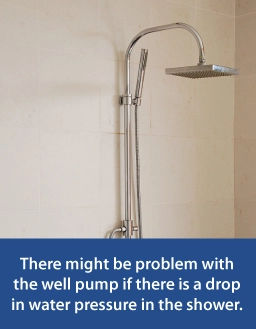
- Low water pressure – A significant drop in water pressure in the shower or during other times could indicate a problem with the well pump.
- Intermittent cycling – If the well water pump turns off and on for no clear reason, there could be a problem with the pressure control switch.
- Short cycling – If the pump turns off too quickly, there may be a loss of air pressure in the control tank due to a clog or a broken control switch.
Contact Mr. Rooter Plumbing of Greater Syracuse
Since 1970, Mr. Rooter Plumbing has been providing expert plumbing services and world-class customer service for residences and business. Since we are a full-service plumbing company, services include diagnosis and checkups, installation and upgrades, system maintenance and cleaning as well as emergency repairs and common plumbing services, such as drain cleaning.
We offer the highest-quality plumbing throughout the greater Syracuse area, from Auburn to Manlius. Call Mr. Rooter Plumbing, and we’ll send one of our licensed plumbers to solve your plumbing problems. Services include:
- Commercial plumbing services – Mr. Rooter Plumbing serves businesses throughout the Greater Syracuse area, offering professional and cost-effective service.
- Residential plumbing services – Mr. Rooter Plumbing offers friendly, affordable service as well as 24-hour emergency repairs. Our technicians offer free estimates before beginning any work and don’t charge for overtime.
When it comes to installing, maintaining, and repairing well water pump systems, Mr. Rooter Plumbing of Greater Syracuse knows the importance of clean, safe water.
Water Well System Maintenance
Yearly checkups from Mr. Rooter Plumbing can help ensure the integrity of your well water system, confirm flow rate, and check seals and flanges for leaks. Service plans can save money on regular maintenance while catching problems early to avoid more expensive repairs.
Emergency Well System Repairs
When your well water system experiences problems, Mr. Rooter Plumbing can diagnose your system and get it up and running again quickly — even in the middle of the night.
Well Pump Repair and Replacement
Mr. Rooter Plumbing offers comprehensive expertise when it comes to home well pump repair. We also supply and install replacement well pumps from leading national manufacturers. Let us help you determine the best unit for your home and also develop a maintenance schedule to prevent future water well problems. We can help you design a new well water system to meet changing needs as well.
If you need to repair or replace a well pump, or you would like to schedule a checkup, request an appointment today.

